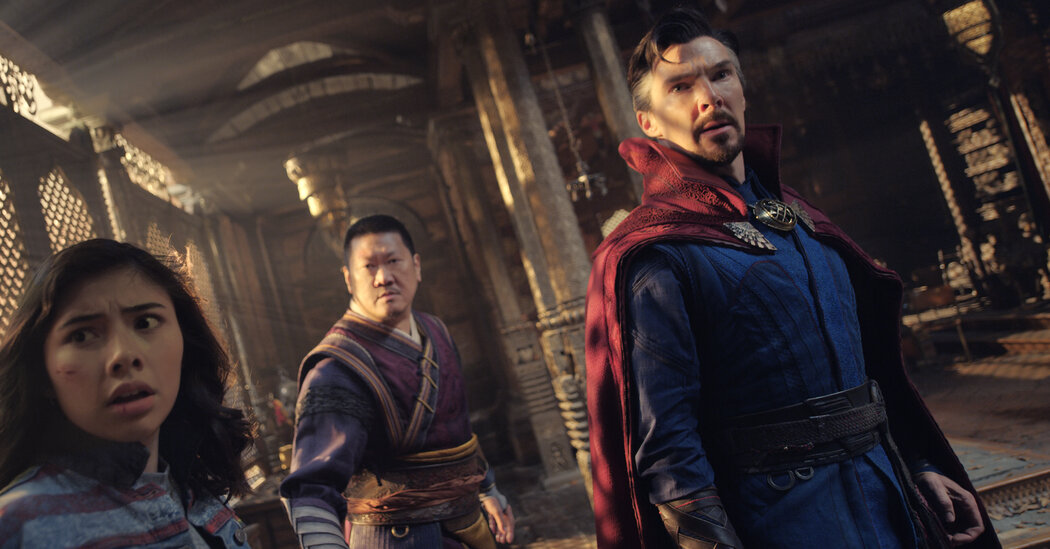
Strange? Madness? Let’s not get carried away.
I’m aware that Strange is the gentleman’s surname — his friends call him Stephen — and that he does indeed have a medical degree. Proper credentials are important in the superhero meritocracy. But like many of his colleagues in the Marvel Cinematic Universe, Dr. Strange (as played by Benedict Cumberbatch) is at most mildly idiosyncratic, with hints of eccentricity in matters of dress and grooming and a whisper of pretentiousness in his attitude. If you call the enchanted garment that drapes itself over his shoulders a cape, he will be sure to remind you that it is properly described as a cloak.
As for madness, the boilerplate on the Disney-Marvel intellectual property terms of service establishes strict parameters for just how crazy things can get. The surprises that await you in “Doctor Strange in the Multiverse of Madness” — likely to elicit whoops and giggles of fan gratification rather than gasps of genuine wonder — have mostly to do with which other Marvel characters show up and in what company. The ones closely associated with Dr. Strange, like Wong (Benedict Wong) and Karl Mordo (Chiwetel Ejiofor), are not unexpected. Not unwelcome either. Nor is a new sidekick named America Chavez (Xochitl Gomez), a teenager with impressive powers but no superheroic identity just yet.
The studio has asked reviewers not to say much more, a request that itself gives away the whole point of the movie. “Doctor Strange in the Multiverse of Madness,” like so many entries in the Marvel canon, functions primarily as an advertisement for and a footnote to other stories. The title may promise abundance, but this cosmos is as gated and defended as any theme park. The signs posted here direct you mostly to the Disney+ pseudo-sitcom “WandaVision” — Elizabeth Olsen returns as Wanda Maximoff, also known as the Scarlet Witch — and the last two “Avengers” movies. Not that advance preparation is required. The ingenuity of the M.C.U. is that you can enter at any point and jump around at will.
Which brings us — heavy sigh — to the multiverse, a narrative conceit recently deployed with infinitely more wit and imagination by the directing duo Daniels in the blessedly unfranchised “Everything Everywhere All at Once.” The “Doctor Strange” rendition is a succession of remarkably similar green-screen projections, with nothing much to distinguish one universe from another. At one point Strange is asked about his universe, which is also ours. “It’s beautiful,” he says, and while I wouldn’t argue with that answer, it does somehow reveal the smallness of this supercosmic vision.
Explore the Marvel Cinematic Universe
The popular franchise of superhero films and TV series continues to expand.
In one of the other universes, there’s no such person as Spider-Man. Let that sink in. An alternate New York City has tropical flora, canals and a statue of Stephen Strange. Green means stop and red means go. Somewhere, Wanda Maximoff tends sheep in an apple orchard, unless she’s pruning apple trees in a sheep meadow.
Most of it looks a lot like Marvel, at least in the first half of the movie, which was directed by Sam Raimi from a script by Michael Waldron. There is a lot of chasing and fighting, with bolts of red, blue or orange light shooting out of characters’ hands. The action happens in generic spaces that evoke no particular place or planet, and periodically stops for a mild joke, a carefully modulated expression of feeling or an explanation of something that might not have needed so much explaining. There are two magic books, one of which is also a shrine at the top of a mountain. The story makes apocalyptic stakes — the fate of the multiverse; the struggle between good and evil — seem curiously trivial.
But as so often happens in the Marvel Cinematic Weltanschauung — often enough to keep even skeptics from giving up on the enterprise entirely — there is an inkling of something more interesting, in this case a Sam Raimi movie.
Raimi is one of the pioneers of 21st-century movie superheroism. His Spider-Man trilogy from the early 2000s still feels relatively fresh and fun. He is also a master of horror, the creator back in the 1980s of the peerlessly ghoulish, funny and profound “Evil Dead” series. And the best parts of “Doctor Strange in the Multiverse of Madness” are the sequences that traffic in zombiism, witchcraft and other dark genre arts.
The creepy-crawly visual effects are much better than the fight scenes, and a sequence in which Danny Elfman’s musical score comes to life (with help from J.S. Bach’s Toccata and Fugue in D minor) has the conceptual wit and visual brio of a Pixar short. Olsen, in both incarnations of her Jekyll-and-Hyde character — the doting, melancholy mother and the raging, vengeful sorceress — is scary not because of her destructive powers or her diabolical ambitions, but because she is so sad.
The intensity of her maternal longing overshadows the romantic disappointment that follows Strange and Christine Palmer (Rachel McAdams). There isn’t much of a love story here. There isn’t much of anything, even as there’s too much of everything. That’s how the Marvel Cinematic Universe functions. Maybe it could be different. Maybe interesting directors like Raimi and Chloé Zhao (who followed the marvelous “Nomadland” with the forgettable “Eternals”) could be allowed to do something genuinely strange with their assignments. But maybe that way madness lies.
Doctor Strange in the Multiverse of Madness
Rated PG-13. Nothing too crazy. Running time: 2 hours 6 minutes. In theaters.



